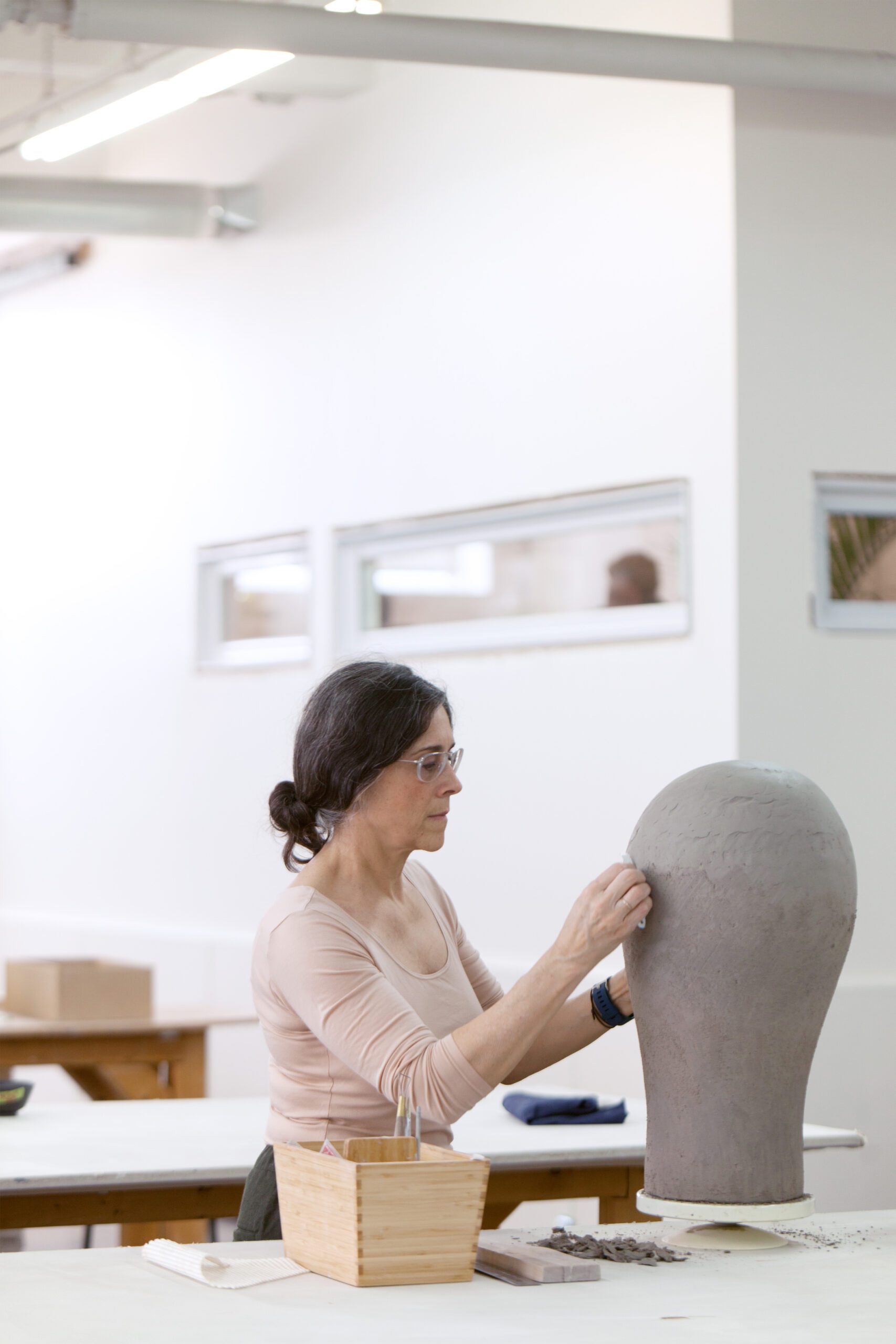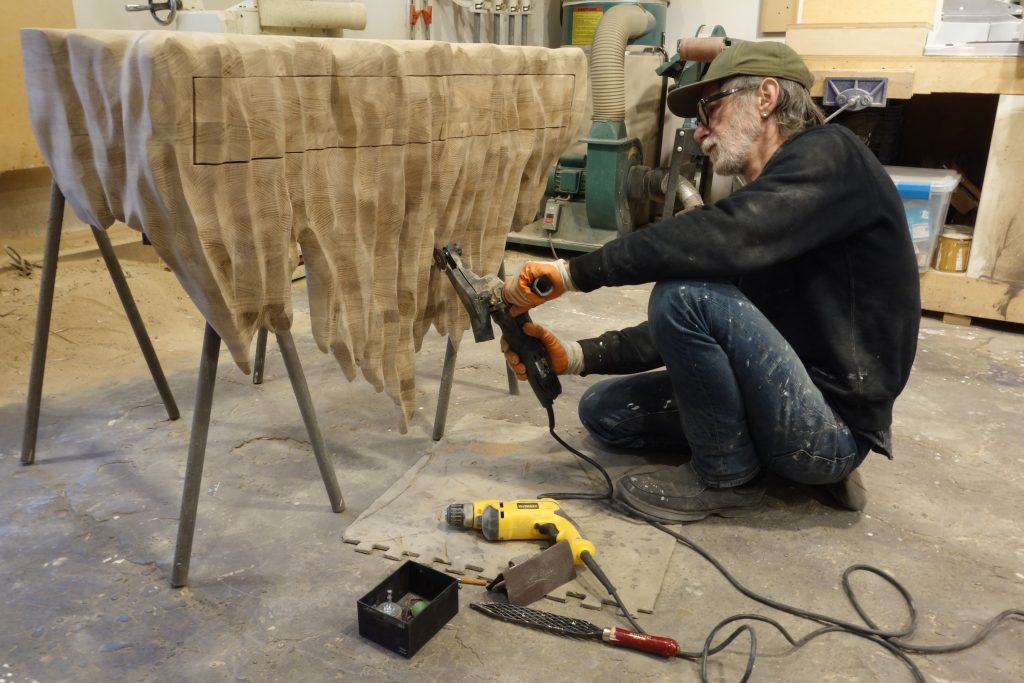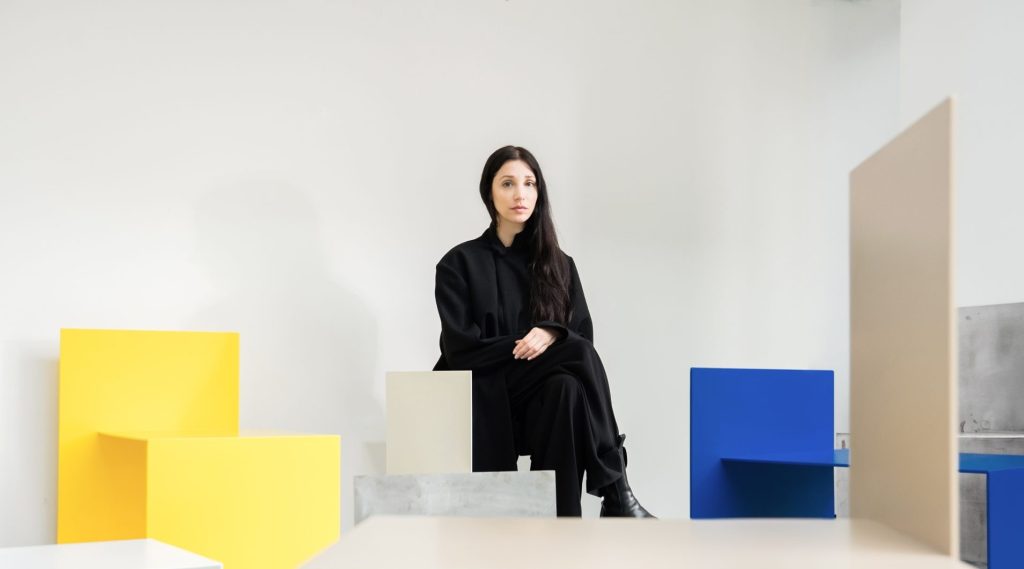

Pascale Girardin: Emotional and Transdisciplinary Dialogue through Clay
“Curiosity has always been a driving force in my life as it opens doors to the unexpected. Biology, art, and design rely on this common principle. I think that experiencing a state of uncertainty and a willingness to explore the unknown shifts your way of seeing and that is very exciting.“
– Pascale Girardin




View Pascale Girardin’s showroom, including “Bust 09”
Working with clay means working with transformation in several ways. Montreal-based designer Pascale Girardin centres her work on this notion, making use of her transdisciplinarity while working with clay. Girardin turned toward art only after studying biology and later trained in the fields of visual art, design, and ceramics. The result of the intersection of these different disciplines are objects whose thoughtful shapes and various surface textures tell of the processual approach she follows.
The two disciplines Girardin combines – art and science – have in common the requirement of observation and interpretation. The different stages that clay goes through during its transformation (including different levels of heat) require strategic work. Furthermore, the choice of glaze depends on the material she works with. Requiring not only a sense for aesthetic, but also an understanding of chemistry, Girardin’s approach gives rise to the versatility that can be seen in both the “Obscuro” or “Poeme” series.
Although this sounds strategic and particular, Pascale Girardin brings another component of transformation into her practice: that of an emotional and relational dialogue. Being respectful and kind to the material means that the material also responds. Not to force a form toward the clay means to not close off oneself to the possible, unforeseen results. In this way, she creates objects which reflect the exchange of knowledge and time for self-reflection, and which have a personality that combines strength and vulnerability.
You have a very diverse background in biology, fine art, and design. How do you see those different subjects coming together in your work?
Curiosity has always been a driving force in my life as it opens doors to the unexpected. Biology, art, and design rely on this common principle. I think that experiencing a state of uncertainty and a willingness to explore the unknown shifts your way of seeing and that is very exciting.




Working in ceramics has been your focus for many years now what fascinates you so much about clay as material?
Its responsiveness to touch and the attentiveness that it requires at every phase of working with it. I become aware of the subtle shifts in the way my fingers or my palms press into it, for example. There is an interdependency in this heightened state which I am grateful for. I often say that clay is my teacher, mirroring my intentions, my focus as well as my distractions! I take this relationship quite seriously.
When we think of clay, we often imagine it in its wet state, soft, pliable, and yielding. As it begins to dry, it offers some resistance and at the same time it is becoming susceptible to warping or cracking. I’ve come to view external strength and hardness as sources of vulnerability, whereas pliability as a form of playful readiness to engage with the hand. It’s a thin line between chaos and order and clay reminds me of this every day.








You have completed quite a few large-scale projects, such as the Four Seasons in Las Vegas and Nobu Downtown in New York. How does that compare to the creation and crafting of smaller pieces?
Large-scale projects are about cooperation and communication, all the while balancing between the potential and limitations of an artisanal studio practice.
In my early years, I produced tableware for restaurants, and this was a training ground as I learned to streamline my production techniques in order to create multiples of a same plate, for example. I worked alone then, and the lack of space, of help and of tooling pushed me to develop ways of working that encouraged a state of flow. What I discovered was that the resulting work reflected this quality. I carry this teaching into my large-scale works whether it is during the ideation phase, communicating with clients or during the production, with my team. Because of the size of my kilns and the challenges that come with working with very large pieces, working with smaller elements enables me to expand my vision to form broader compositions.




Can you take us through the creative process using one of the pieces as an example?
When I was commissioned by David Rockwell to create two large murals and a sake room divider for Nobu Downtown, the key word that was given to me by the design team was the Japanese term Sumi-e, which loosely translates to “black ink painting”. This traditional art requires commitment and focus as the ink-ladened brush touches the paper. The concept energized me and I saw parallels with my own practice coupled with my interest in Zen Buddhist philosophy.
In the beginning, I played around with a hake brush and wiped ink onto paper to see how I could interpret a large swooping brushstroke in ceramics. The bristles created fine stipples on the paper’s surface and I imagined these stipples as small black sticks. It was important to me that each element and their surface texture be unique so as to create an organic feeling. Up close, these pieces reminded me of charcoal, which upon further investigation, I discovered is a close cousin to soot which was traditionally used to make ink in many countries. The final compositions were based on my original brush paintings which I subdivided into small strokes using a felt tip pen and tracing paper. Once digitized and scaled up, we printed a template for the onsite installation.
For the sake room divider, I recalled a trip to the Aichi Prefectural Ceramic Museum in Seto Japan. The region was famous during the Momoyama and Edo periods for the production of large sake vessels used to transport the rice wine to the local sake shops. I drew inspiration from their singular shapes and sketched a series of bottles to line the shelves of the two dividers. The wheel throwing was done by Christian Roy, a local potter, whereas I painted each one with a deep blue glaze brushstroke, using various brushes acquired during my travels to China and to Japan.






What is the philosophy behind the colours you chose, and how long does it take you to develop them?
Making your own glaze is an adventure. Developing a new recipe and testing it on a small sample offers a glimpse at its potential. However, a new glaze needs to be applied on numerous surfaces – textured, flat, vertical, convex, or concave walls may yield different results. The application method, the type of clay and the pieces’ thickness are other variables that impact colour, viscosity, and opacity. There are so many factors involved in the process of glaze development that arise from trial and error. One needs to have low expectations plenty of time and an open mind.
My choice of colours is aligned with the form and surface of the pieces that I’m working on. I do have a weakness for cobalt blues, particularly the inky blackish blue ones. For the “Figura” series, I wanted a dark monochromatic surface that reminded me of encaustics. There is something highly tactile about their surface and their form. It’s as though they are waiting to be embraced.






What other projects can we expect in the future?
I’m in the process of developing a new colour palette for the “Figura” series, and have a few exhibits planned for 2023. There are some large-scale mural projects expected to be installed in the UAE in 2023, however, I can’t disclose this information until the projects are finished.
Bio
For more than 20 years, Pascale Girardin has been navigating between the world of ceramics, visual arts and design, instilling her unique vision upon the art objects, tableware and architectural installations that she creates. Inspired by the expression of pure forms, her art discreetly highlights our fundamental relationship to the world in which we live. Whether suspended, adorning a wall or floating in the water, her works recall the omnipresence and organic structure of nature.
Originally trained as a painter, Pascale Girardin ’s interest in both art and science led her to study biology (Université de Montréal), design (Certificate in Digital Technologies, Concordia University) ceramics (Centre de Céramique Bonsecours) and visual arts (BFA Concordia University). With the goal of enhancing her ability to conduct thoughtful research and to continue nourishing her work Girardin has recently graduated (Maîtrise ès Arts) from the Université du Québec à Montréal.
Her work as a visual artist and designer has earned her several awards and distinctions, including the Pierre-Pagé Prize and grants from the Canada Council for the Arts and the Conseil des arts et des lettres du Québec. Pascale Girardin’s work complements the architecture of many luxury establishments around the world, including Nobu Broadway, Four Seasons Montreal, Saks Fifth Avenue, Clement Restaurant in New York, Four Seasons Private Residences Pudong, Printemps Paris and Al Badia Golf Club in Dubai.









